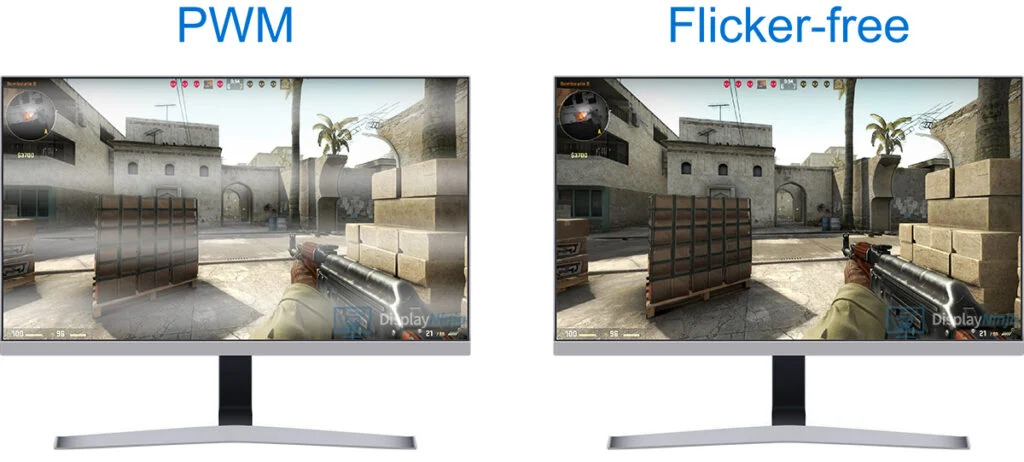If you’ve ever ended a long workday with dry eyes, a dull headache, or just that tired, strained feeling behind your eyes, you’re definitely not alone. Screens are everywhere—from work to entertainment—and we spend hours in front of them without thinking much about what’s really going on behind those glowing pixels. But here’s something most people don’t realize: not all monitors are created equal, and some are much easier on your eyes than others. That’s where flicker-free monitors come in.
The Basics: What is a Flicker-Free Monitor?
A flicker-free monitor is exactly what it sounds like: a screen that doesn’t flicker. That might seem like a small detail, but it makes a big difference—especially if you spend more than a couple of hours in front of a screen each day. Most standard monitors use something called PWM (Pulse Width Modulation) to control brightness. This method rapidly turns the screen’s backlight on and off, creating a flicker that our eyes can’t consciously detect. Even though you may not see it, your eyes do, and over time, this subtle flickering can lead to fatigue, headaches, and even long-term eye strain.

In contrast, flicker-free monitors use DC (Direct Current) modulation to maintain a consistent backlight without any rapid on-off cycles. That means a smoother, more stable image—and less stress on your eyes.
Why Does Screen Flicker Happen?
To understand why monitor flicker happens in the first place, it helps to know how LED backlights work. LED-lit monitors are brighter and more efficient than older technologies, but they still need a way to control how bright the screen appears to you. PWM is the easiest way to do that: it dims the light by rapidly switching it on and off. The lower the brightness setting, the longer the “off” periods last—leading to more noticeable flicker.

Even though this flickering happens too quickly for most people to consciously see, it still triggers a physical response in your eyes. Your pupils constantly react to changes in brightness, and this tiny, repeated adjustment is what leads to digital eye strain over time.
Symptoms of Eye Strain From Non-Flicker-Free Monitors
You’ve probably felt it before. After a few hours of working, your eyes feel dry. Maybe things look a little blurry. You rub your temples, blink a few times, and chalk it up to just being tired. But in many cases, the real culprit is on-screen flicker. Studies show that after just three or four hours in front of a traditional screen, more than 90% of people experience eye discomfort.
Common symptoms include:
- Dry, irritated eyes
- Blurry or double vision
- Headaches or a pressure-like feeling behind the eyes
- Increased sensitivity to light
- Difficulty focusing after screen use
If you’re using a monitor that isn’t flicker-free, these symptoms could hit you harder and more often.
Are Flicker-Free Monitors Worth It?
Absolutely—especially if your work or hobbies keep you in front of a screen all day. A flicker-free gaming monitor can make long sessions more comfortable, while professionals editing video or working with design software will appreciate the consistent backlighting and visual stability. Even casual users will benefit, especially when paired with low blue light technology.
And here’s the best part: flicker-free doesn’t have to mean expensive. Some of the best flicker-free monitors, like the BenQ Flicker-Free Monitor, Dell Flicker-Free Monitor, and LG Flicker-Free Monitor, are available across various price ranges. Brands like ASUS, Samsung, and Philips also offer flicker-free models designed for gaming, content creation, or everyday office use.
How to Check If Your Monitor Is Flicker-Free
Not sure if your current monitor is flicker-free? Here’s a quick test you can try with your smartphone:
- Turn your monitor’s brightness to maximum.
- Open your phone’s camera and point it at the screen.
- Slowly reduce the screen’s brightness while watching through the phone.
If you notice bands or flickering on your phone’s screen, that likely means your monitor isn’t flicker-free. The flicker-free monitor test is a simple way to see what your eyes are dealing with every day.
What to Look for in a Flicker-Free Monitor
When shopping for a flicker-free monitor, pay attention to a few extra features that can make your viewing experience even more comfortable:
- Low Blue Light Technology: Helps reduce exposure to high-energy visible light that contributes to eye fatigue.
- High Refresh Rates: Especially important for gaming, where smooth visuals can reduce motion blur and strain.
- Adjustable Stands and Ergonomics: Proper screen positioning can further reduce stress on your eyes and neck.
- Matte Screens: Help minimize glare from ambient lighting.
Models like the ASUS VX248H Gaming Monitor, Samsung Flicker-Free Monitor, and ASUS VA279HAEL 27″ Full HD Flicker Free LED Monitor combine multiple eye-care technologies for an optimal setup.
Why Gamers and Creators Should Care
If you’re a gamer, you already know that smooth visuals are everything. A flicker-free 144Hz monitor can reduce eye strain while keeping you competitive in fast-paced environments. Combine that with a flicker-free low blue light monitor, and you’ve got a setup that keeps you playing longer without feeling wiped out.
Creators working with color-sensitive tasks like photo editing, graphic design, or 4K video will appreciate the stability of 4K flicker-free monitors and flicker-free IPS monitors, where every detail matters and screen flicker can be a major distraction.
Not All Flicker-Free Monitors Are the Same
It’s important to note that some monitors advertise flicker-free technology but don’t truly eliminate flicker. Instead, they just shift the frequency of the flickering to a point where it’s harder to perceive—but your eyes still react to it. Reliable brands like BenQ, ASUS, and Philips use DC dimming to provide a genuinely flicker-free experience that has been certified by TÜV Rheinland and other global safety bodies.
For example, the BenQ Flicker-Free Monitor was one of the first truly flicker-free models on the market, backed by scientific testing and input from ophthalmologists. The Philips 279X6QJSW 27″ Curved Monitor also includes flicker-free tech and eye care features.
Final Thoughts: Should You Upgrade to a Flicker-Free Monitor?
If you spend even a few hours a day staring at a screen, a flicker-free monitor isn’t just a luxury—it’s an investment in your long-term eye health. From reducing headaches and fatigue to helping you stay focused longer, the benefits are real. Whether you’re working, gaming, creating, or just browsing, the right screen can make all the difference.
And with so many options available—Dell Flicker-Free Monitors, Samsung 24-Inch Flicker-Free LED Monitors, ASUS Flicker-Free Gaming Monitors, and even portable flicker-free monitors—you’re bound to find one that fits your needs and budget.
So next time you’re shopping for a monitor, don’t just look at size, resolution, or refresh rate. Ask one more important question: “Is it flicker-free?”
References
- https://www.viewsonic.com/library/tech/how-flicker-free-monitors-contribute-to-eye-health/#:~:text=Flicker%2Dfree%20monitors%20are%20specially,of%20issues%2C%20including%20eye%20strain.
- https://www.benq.com/en-us/knowledge-center/knowledge/what-is-flicker-free-monitor.html
- https://en.wikipedia.org/wiki/Flicker-free